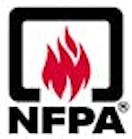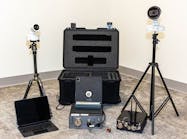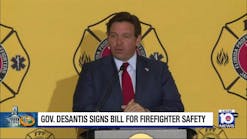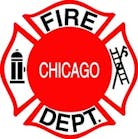I have been near-sighted (could see things up close) for over 30 years and my vision was now to the point that the lenses in my glasses had become very thick. Most things that were any distance away were now pretty much a blur without glasses. Throughout my career I have wrestled with the frustration of glass frames for self-contained breathing apparatus (SCBA). Every time there was a working fire, I would have to remove my regular glasses and place them in a safe place while donning my SCBA facepiece. I lost count on the number of glasses that I damaged throughout my career during this process.
About three years ago, I decided to begin looking into LASIK surgery. Now as a chief officer, my circumstances are a little different. I will use this article to do my best to share my experience with you. I have also included a digital streaming video of the procedure that was done on my eyes. This way you can truly see what I went through first-hand.
What is LASIK Surgery?
LASIK (an acronym for the medical term laser assisted in-situ keratomileusis) surgery is a two-step method for vision correction. The first step involves the creation of a flap of corneal (surface) tissue by a slight incision. The second step is where the laser is used. During the second step, the flap is lifted and the laser reshapes the surface of the cornea. Small layers of the cornea are removed and are done through an automated process. The cornea is then reshaped in a way that flattens or steepens the cornea based on what is needed to correct the vision. This automated process works in conjunction with a computer map that is created by a scan of the eyes prior to surgery. The scan that is conducted to create the mapping is done through your visualization of light waves in comparison to perfect vision and the process is painless.
The laser works through a powerful beam of ultraviolet light controlled by the doctor. It also is super sensitive, such that it accommodates for eye movement. This beam of light does not contact any of the other eye structures such as the iris, lens or retina; therefore they are not affected.
The LASIK procedure is a two-step process. First it involves an appointment for the eye scan and mapping followed up during another appointment for the actual surgery. The first appointment was free and also performed an assessment to determine if I was a viable candidate for LASIK.
Some of the results for this procedure are referenced below:
In the FDA study, one year after the procedure:
- 100% of participants could pass a driving test without glasses or contact lenses
- 98% of participants could see 20/20 or better without glasses or contact lenses
- 70% of participants could see better than 20/20 without glasses or contact lenses
In addition, many participants reported that they had clearer, better vision both during the day and at night, compared to their vision with glasses or contact lenses before the procedure.
My Experience
Scan and mapping of the eye and cornea was relatively simple and painless. It involved the use of eye drops that dilated the pupils and made me very sensitive to light for about an hour. While the drops were activated, I sat and looked into a device where a bright light shined into the eye. During this time period, I was told to focus into the center of the light. After doing this several times, the scanning and mapping was complete. As I was told, this set of measurements was then stored onto a memory card and was later inserted into the laser where it guided the laser's reshaping of the cornea.
The period just prior to the actual surgery was the time when my mind began to wander to thoughts of doubt. What if something goes wrong? What if I can't see then what will I do? Will night vision be a problem for me with a halo or starbursts? And when my son Nick asked the blunt and disturbing question, "Dad, can this make you go blind, then why are you doing it?" All of these questions began to make me think that wearing glasses might not be so bad after all. After reassurances from friends that had great experiences and my eyes stopped watering, I set the final date.
The Day of the Procedure
I was a bit anxious on the day of the actual surgery but was now determined to get it done. I was situated into a chair that reclines slightly with the head a little lower. Eye drops were placed in the eyes for numbing and the immediate area on the face surrounding the eyes were coated with an antiseptic. Each eye was done one at a time. A device then clamped onto the eyelid of the surgery eye to hold it open while the procedure continued. The next step was a rather odd experience but the doctor prepared me for it. At this time a device created suction on the eyeball itself and I could feel the pressure as it pulled, but it was not painful. The doctor explained that at some point that my vision would go totally dark. The purpose of this is to hold the eyeball in place.
The next part of the procedure was the actual cutting and creation of the corneal flap. During this time I felt a very brief sting which was over before even mentioning it. All of this procedure moved along methodically and relatively quickly. Once the flap was cut and opened, the laser went to work. I was told to look at the light and focus on it. Then the laser reshaped the cornea and there is a tapping sound that continued for about 10 seconds.
The laser was done on the first eye. The doctor then replaced the flap and smoothed the flap back to its original position and eliminated any air bubbles. The procedure was repeated on the second eye. The entire preparation and procedure took about 20 minutes.
Following this outpatient procedure, the doctor reexamined both eyes and checked for the placement of the flap. Additional eye drops were given to prevent infection and keep the eyes moist. Over the counter pain medicines were recommended to help reduce any pain following the procedure. Immediately following the procedure my eyes were dry and it felt as though I was squinting. There was a slight feeling of a burning discomfort but nothing unbearable. For a period of at least an hour or two, the doctor recommended that I keep my eyes closed and sleep. This helped overcome the minimal discomfort and to let the eyes begin to heal. My wife Judy accompanied me, watched the procedure and drove me home.
Once I arrived home, I put eye drops in my eyes to keep them moist and promptly took a nap for about two hours. My eyes were still sensitive to light so I kept the room dark. After my nap, all of the discomfort was gone but my eyes were still too sensitive to light so I continued to rest in a dark room for another two hours. Now I began to look around with my new eyes; the vision correction was nothing short of phenomenal. At first, my vision was still blurred (which is expected) but as the night progressed my vision continually and gradually got better. I could already see clearly without glasses.
My eyes remained dry and required regular application of eye drops every couple of hours. The doctor advised that this would continue for three to six months as the eyes heal. For me it continued for four months as my eyes gradually returned to normal.
The Upside
The very next day I was amazed at the difference in my vision. I could see everything in such crisp detail and my vision was corrected to 20/20. Even with updated prescription glasses, I could not see objects at a distance as I could now. I could see intricate detail of squirrels up high in trees and the pine needles up in the treetops. As I began to drive around, I quickly noticed the clear lines of other vehicles, I could read license plates from far distances and traffic signs were now much clearer. Oh yes, I could read and differentiate hazardous materials placards on trucks from much further away than before - a real bonus.
In the night sky, I could see so many more stars. I could see planes flying and I could see three of their blinking lights. At one point, I thought I could see the pilot waving at me (just kidding). As far as night driving, I could see traffic signs, vehicles, tail lights, license plates, etc. I could also see much more detail operating at emergency incidents. I did not experience any halos or other night vision problems.
On the fireground, I could see much more of the detail of what people were doing, what tools they were using and even fire hotspots in the eaves of a house that was on fire. I could recognize firefighters much better from significant differences. Until I had LASIK surgery, I didn't realize how much I was missing.
The Downside
Since the age of 14, I wore glasses all of the time and was accustomed to always wearing them. Once I had the LASIK surgery done, I did not need glasses except to read or to see things up close. This change meant that I now need glasses just for the purpose of reading and that I must have glasses close by. There is a LASIK procedure called monovision that can overcome this by correcting one eye to clear distance vision (far-sighted) and the other eye to comfortable near vision (near-sighted). Monovision works after the brain automatically adjusts. The advantage of this procedure is that a person can see both near and far without glasses. It does require a period of weeks or months to adjust. I did not choose this because I understood that it might have adverse affects at night. Doctors can provide contact lenses to simulate this vision. Also once you have had a LASIK procedure, you can have another to change it, usually at no cost.
As it relates to the emergency services, I believe that the need for glasses to see up close could be a serious disadvantage in a performing intricate fire, hazmat or EMS procedures and will have to be taken into consideration.
Considerations and Risks
There are a number of considerations. First I had to determine if I was a viable candidate. In order to do this, I had to select a reputable LASIK surgeon. I researched various options on the web and spoke to friends that had LASIK surgery to learn about their experiences and results. Then I had to decide on monovision versus the routine LASIK. I chose the routine LASIK for clear distance vision in both eyes.
There are also different types of LASIK. There is the older traditional LASIK that does not scan or map the cornea and they are much cheaper although the results are less effective. I was also concerned about the horror stories about night glare or halos but that has been overcome by a new scanning/mapping procedure that expands the area of the corneal correction that extends out further over the pupils.
There are always risks from such a surgery such as loss of vision, infection and so on. I took a great deal of time and read much on LASIK surgery and talked to many friends who had undergone the procedure. I would suggest that you do the same before jumping into any type of surgery. It is also important to check out the doctor and his/her reputation.
There is also a period of time after the LASIK procedure for follow-up and/or correction. My procedure has a two-year period after which any additional care needed is covered free of charge. If I chose to change to have the monovision procedure within the two year period, that would be done free of charge. Other services offer lifetime correction at no charge.
Costs
The costs for LASIK vary between the offices. The surgeon that I chose was Dr. Garth Stevens, Jr. and his office (LASIK Center of Virginia) normally charges $2800 per eye for the custom wave/map LASIK. However, Dr. Stevens provided me with a 50% discount because I of my public safety affiliation which he provides to all others that serve in the fire service, law enforcement or EMS.
Today, I can honestly say that I am very pleased with the results and that I took advantage of the LASIK surgery. I have provided the streaming video for you to see the actual procedure that was done on my eyes. However, any decision on whether or not this is right for you must be made by you and only after thorough research and understanding of the risks.

Charles Werner
CHARLES WERNER, who is a Firehouse contributing editor, is a 45-year veteran of public safety. He served with the Charlottesville, VA, Fire Department for 37 years, serving the past 10 years as chief. Following retirement, Werner served for two years as senior adviser and acting deputy state coordinator for the Virginia Department of Emergency Management. He has chaired: DHS SAFECOM Executive Committee; IAFC Technology Council; National Information Sharing Consortium; and DHS/White House Incident Management Information Sharing SubCommittee. Werner currently serves as the director of DroneResponders Public Safety Alliance, chair of the National Council on Public Safety UAS and chair of the Virginia Secure Commonwealth UAS Sub Panel.





